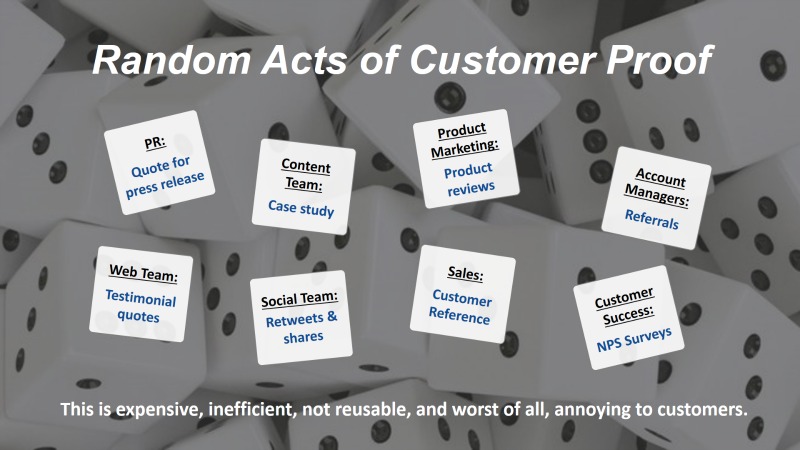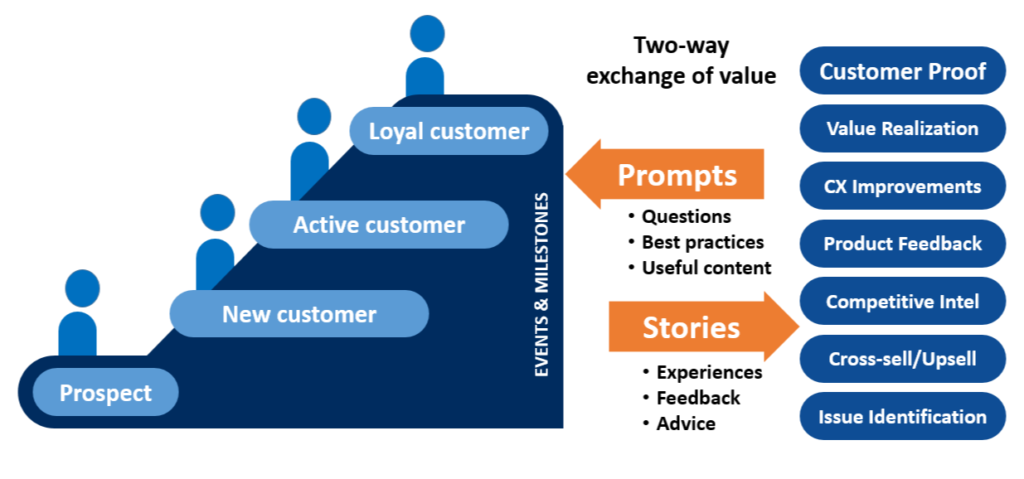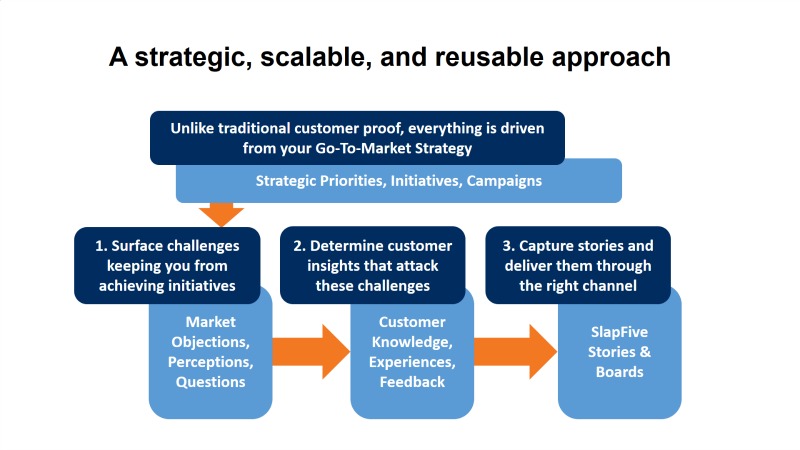Our approach to Customer Marketing and Engagement is so different from what most companies do today that you may need to unlearn some outdated habits and conventional thiniking. You see, most companies do what I call Random Acts of Customer Proof.
SlapFive's Approach to Customer Marketing & Advocacy
SlapFive’s Approach to Customer Voice & Engagement

I’m sure you can relate. Especially if your company does things like this:
- The PR folks need a customer quote for a press release, so they ask a few customers
- A customer raises their hand and agrees to do a case study, so the 3 month process of writing a classic case study begins
- A sales rep needs a customer to do a reference call, so the company-wide email goes out looking for a reference customer
- The product marketing team wants more product reviews on G2Crowd, so they offer a reward to a bunch of customers if they’ll kindly write a 5-star review
This Random Acts of Customer Proof approach is bad for so many reasons, among them:
- Each need for customer evidence turns into a fire drill to find a customer to agree
- It is not efficient, scalable or reusable
- Because it is totally reactive, the customer proof is rarely aligned with the biggest questions, fears and doubts of your buyers
- It annoys customers to be pestered by different parts of your organization, asking for favors
SlapFive solves all these problems, once and for all.
With SlapFive, you engage customers in an on-going program, where they have opted in to participate in different types of activities. Unlike Customer Advocacy Programs, this is a two-way exchange of value. Your customers get even more out of this engagement than your company does, so they love to participate.
And the result of this engagement? You amass a treasure trove of amazing content, in audio and video formats, that can be infused into every marketing and sales initiative, as well as inform your product and customer experience improvement efforts.

SlapFive takes a much more strategic, surgical, top-down approach to customer engagement and evidence that ensures your customer marketing efforts are having maximum impact on your company’s most important growth initiatives.

If you want to capture and unleash customer stories that have direct impact on revenue growth, you need to start by looking at your most important go-to-market strategies, initiatives, or campaigns, and align the stories you capture and unleash to them.
We have a 3 step process for doing this, that sounds super-simple, and actually is not that hard to do, but it requires you to open up your mind to a new way of thinking about customer engagement, and forget those classic case studies, testimonials quotes, and reference programs.
Step 1: Surface the challenges or obstacles keeping you from achieving your go-to-market strategies and initiatives
These are things like:
- Your buyers have a lack of urgency because they don’t understand how big or costly their problem is, or don’t look at your solution as a “must have”
- A competitor is eating into your market share, or you’re looking to steal customers from a competitor
- There’s a misperception in the market about your company or offering
- A frequent objection or doubt stops interested parties in their tracks
- You have a competitive advantage that is unknown or hard to explain
- You’re launching a new product
- Your customers are nervous about migrating from a legacy product to your new product
- Like every other B2B company, you’re trying to get some Account-Based Marketing going to cross-sell and upsell
- The list is endless
Step 2: Determine what types of customer insights, told in the customers’ voices, can knock down these challenges
These are things like:
- Customers talk about a successful initiative with your company
- Customers give advice on how their peers should evaluate possible solutions and what criteria they should use to make the decision
- Customers describe the top reason they migrated from a competitor to your solution
- Customers share why solving this problem was so urgent to their business
- Customers give feedback on their experience working with your firm
- Customers share their knowledge of a creative way they’ve used your solution
- This list is also endless
Of course, once you figure out what knowledge, advice, insights, and feedback you want to capture, you frame it as direct, surgical questions to ask customers.
Step 3: Capture customer stories, and assemble and deliver them to solve the right use cases, through the right channels
These are ways to capture customer stories.